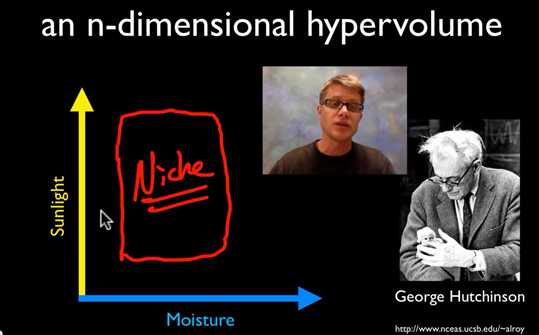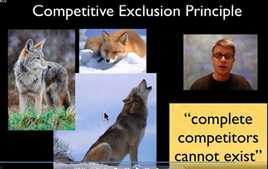标签:
biotic 生物的 [bai‘?tik,-k?l]adj
of or relating to living organisms
vacant空的
underbrush 林下灌木丛
The Hutchinsonian niche is an n-dimensionalhypervolume, where the dimensions are environmental conditions and resources, that define the requirements of an individual or a species to practice "its" way of life, more particularly, for its population to persist.[2] The "hypervolume" defines the multi-dimensional space of resources (e.g., light, nutrients, structure, etc.) available to (and specifically used by) organisms, and "all species other than those under consideration are regarded as part of the coordinate system.

In ecology, a niche (CanE, UK /?ni??/ or US /?n?t?/)[1] is a term with a variety of meanings related to the behavior of a species living under specific environmental conditions.
生态位描述:在特定环境下,一个物种的行为方式。
The ecological niche describes how an organism or population responds to the distribution of resources and competitors (for example, by growing when resources are abundant, and whenpredators, parasites and pathogens are scarce) and how it in turn alters those same factors (for example, limiting access to resources by other organisms, acting as a food source for predators and a consumer of prey). "The type and number of variables comprising the dimensions of an environmental niche vary from one species to another [and] the relative importance of particular environmental variables for a species may vary according to the geographic and biotic contexts".[3]
The notion of ecological niche is central to ecological biogeography, which focuses on spatial patterns of ecological communities.[4] "Species distributions and their dynamics over time result from properties of the species, environmental variation..., and interactions between the two — in particular the abilities of some species, especially our own, to modify their environments and alter the range dynamics of many other species."[5]Alteration of an ecological niche by its inhabitants is the topic of niche construction.[6]
The majority of species exist in a standard ecological niche, but there are exceptions. A premier example of a non-standard niche filling species is the flightless, ground-dwellingkiwi bird of New Zealand, which feeds on worms and other ground creatures, and lives its life in a mammal niche. Island biogeography can help explain island species and associated unfilled niches.
The ecological meaning of niche comes from the meaning of niche as a recess in a wall for a statue,[7] which itself is probably derived from the Middle French word nicher, meaning to nest.[1][7] The term was coined by the naturalist Roswell Hill Johnson[8] but Joseph Grinnellwas probably the first to use it in a research program in 1917, in his paper "The niche relationships of the California Thrasher".[9][10]
The Grinnellian niche concept embodies the idea that the niche of a species is determined by the habitat in which it lives and its accompanying behavioral adaptations. In other words, the niche is the sum of the habitat requirements and behaviors that allow a species to persist and produce offspring. For example, the behavior of the California Thrasher is consistent with the chaparral habitat it lives in—it breeds and feeds in the underbrush and escapes from its predators by shuffling from underbrush to underbrush. Its ‘niche‘ is defined by the felicitous complementing of the thrasher‘s behavior and physical traits (camouflaging color, short wings, strong legs) with this habitat.[9]
This perspective of niche allows for the existence of both ecological equivalents and empty niches. An ecological equivalent to an organism is an organism from a different taxonomic group exhibiting similar adaptations in a similar habitat, an example being the differentsucculents found in American and African deserts, cactus and euphorbia.[11] As another example, the Anolis lizards of the Greater Antilles are a rare example of convergent evolution, adaptive radiation, and the existence of ecological equivalents: the Anolislizards evolved in similar microhabitats independently of each other and resulted in the same ecomorphs across all four islands.
In 1927 Charles Sutherland Elton, a British ecologist, defined a niche as follows: "The ‘niche‘ of an animal means its place in the biotic environment, its relations to food and enemies."[12]
Elton classified niches according to foraging activities ("food habits"):[13] "For instance there is the niche that is filled by birds of prey which eat small animals such as shrews and mice. In an oak wood this niche is filled by tawny owls, while in the open grassland it is occupied by kestrels. The existence of this carnivore niche is dependent on the further fact that mice form a definite herbivore niche in many different associations, although the actual species of mice may be quite different."

The Hutchinsonian niche is an n-dimensional hypervolume, where the dimensions are environmental conditions and resources, that define the requirements of an individual or a species to practice "its" way of life, more particularly, for its population to persist.[2] The "hypervolume" defines the multi-dimensional space of resources (e.g., light, nutrients, structure, etc.) available to (and specifically used by) organisms, and "all species other than those under consideration are regarded as part of the coordinate system."
Hutchinsonian生态位是一个多维体积,包括:环境条件,资源。这些因素定义了个人或物种生活方式,更特殊的,为了它们的人口能持续。生态位的物种可以获得光照,营养,结构,这些物质是和谐体系一部分。
The niche concept was popularized by the zoologist G. Evelyn Hutchinson in 1957.[14] Hutchinson wanted to know why there are so many types of organisms in any one habitat. His work inspired many others to develop models to explain how many and how similar coexisting species could be within a given community, and led to the concepts of ‘niche breadth‘ (the variety of resources or habitats used by a given species), ‘niche partitioning‘ (resource differentiation by coexisting species), and ‘niche overlap‘ (overlap of resource use by different species).
多种物质在同一个社区内共生。
Statistics were introduced into the Hutchinson niche byRobert MacArthur and Richard Levins using the ‘resource-utilization‘ niche employing histograms to describe the ‘frequency of occurrence‘ as a function of a Hutchinson coordinate.[2][16] So, for instance, a Gaussian might describe the frequency with which a species ate prey of a certain size, giving a more detailed niche description than simply specifying some median or average prey size. For such a bell-shaped distribution, the position, widthand form of the niche correspond to the mean, standard deviation and the actual distribution itself.[17] One advantage in using statistics is illustrated in the figure, where it is clear that for the narrower distributions (top) there is no competition for prey between the extreme left and extreme right species, while for the broader distribution (bottom), niche overlap indicates competition can occur between all species. The resource-utilization approach consists in postulating that not only competition can occur, but also that it does occur, and that overlap in resource utilization directly enables the estimation of the competition coefficients. [18] This postulate, however, can be misguided, as it ignores the impacts that the resources of each category have on the organism and the impacts that the organism has on the resources of each category. For instance, the resource in the overlap region can be non-limiting, in which case there is no competition for this resource despite niche overlap.[15][18][10]
An organism free of interference from other species could use the full range of conditions (biotic and abiotic) and resources in which it could survive and reproduce which is called its fundamental niche.[19] However, as a result of pressure from, and interactions with, other organisms (i.e. inter-specific competition) species are usually forced to occupy a niche that is narrower than this, and to which they are mostly highly adapted. This is termed the realized niche.[19] Hutchinson used the idea of competition for resources as the primary mechanism driving ecology, but overemphasis upon this focus has proved to be a handicap for the niche concept.[15] In particular, overemphasis upon a species‘ dependence upon resources has led to too little emphasis upon the effects of organisms on their environment, for instance, colonization and invasions.[15]
The term adaptive zone was coined by the paleontologist George Gaylord Simpson to explain how a population could jump from one niche to another that suited it, jump to an ‘adaptive zone‘, made available by virtue of some modification, or possibly a change in the food chain, that made the adaptive zone available to it without a discontinuity in its way of life because the group was ‘pre-adapted‘ to the new ecological opportunity.[20]

Hutchinson‘s "niche" (a description of the ecological space occupied by a species) is subtly different from the "niche" as defined by Grinnell (an ecological role, that may or may not be actually filled by a species—seevacant niches).
A niche is a very specific segment of ecospace occupied by a single species. On the presumption that no two species are identical in all respects (called Hardin‘s ‘axiom of inequality‘[21]) and the competitive exclusion principle, some resource or adaptive dimension will provide a niche specific to each species.[19] Species can however share a ‘mode of life‘ or ‘autecological strategy‘ which are broader definitions of ecospace.[22]For example, Australian grasslands species, though different from those of the Great Plains grasslands, exhibit similar modes of life.[23]
Once a niche is left vacant, other organisms can fill that position.
一旦某个生态位空了,其它物种会占领空地。
For example, the niche that was left vacant by the extinction of the tarpan has been filled by other animals (in particular a small horse breed, thekonik). Also, when plants and animals are introduced into a new environment, they have the potential to occupy or invade the niche or niches of native organisms, often outcompeting the indigenous species. Introduction of non-indigenous species to non-native habitats by humans often results in biological pollution by the exotic or invasive species.
The mathematical representation of a species‘ fundamental niche in ecological space, and its subsequent projection back into geographic space, is the domain of niche modelling.[24]
The different dimensions, or plot axes, of a niche represent different biotic and abiotic variables. These factors may include descriptions of the organism‘s life history, habitat, trophic position (place in the food chain), and geographic range. According to thecompetitive exclusion principle, no two species can occupy the same niche in the same environment for a long time.
两个不同物种不能同时占领同一个生态位。
The parameters of a realized niche are described by therealized niche width of that species.[25]

标签:
原文地址:http://www.cnblogs.com/biopy/p/4800336.html